 W
WCycling, also called bicycling or biking, is the use of bicycles for transport, recreation, exercise or sport. People engaged in cycling are referred to as "cyclists", "bicyclists", or "bikers". Apart from two-wheeled bicycles, "cycling" also includes the riding of unicycles, tricycles, quadricycles, recumbent and similar human-powered vehicles (HPVs).
 W
WCurrent technological developments suggest that cars, as used today, will be replaced. Established alternatives to car use include cycling, walking, kick scooters, rollerblading, skateboarding, twikes and motorcycles. Other alternatives are public transport vehicles.
 W
WAqua cycling or aqua spinning is a technique in fitness training. In aqua cycling, a stationary apparatus similar to a bicycle frame is submerged in a pool, while its rider's upper body remains above the water.
 W
WBicycle and motorcycle dynamics is the science of the motion of bicycles and motorcycles and their components, due to the forces acting on them. Dynamics falls under a branch of physics known as classical mechanics. Bike motions of interest include balancing, steering, braking, accelerating, suspension activation, and vibration. The study of these motions began in the late 19th century and continues today.
 W
WA bicycle carrier, also commonly called a bike rack, is a device attached to an automobile or bus for transporting bicycles.
 W
WBicycle counters are electronic devices that detect the number of bicycles at a location for a certain period of time. Some advanced counters can also detect the speed, direction and type of bicycles. These systems are sometimes referred to as bicycle barometers, but the term is misleading because it indicates the measurement of pressure. Most counting stations only consist of sensors, the internal computing device, and some use a display to show the total number of cyclists of the day and the current year. There are counting stations all over the world in over hundreds of cities, for example in Manchester, Zagreb, or in Portland. The first bicycle counting station was installed in Odense, Denmark, in 2002.
 W
WA bicycle's performance is extraordinarily efficient. In terms of the amount of energy a person must expend to travel a given distance, cycling is calculated to be the most efficient self-powered means of transportation. In terms of the ratio of cargo weight a bicycle can carry to total weight, it is also a most efficient means of cargo transportation.
 W
WBicycle poverty reduction is the concept that access to bicycles and the transportation infrastructure to support them can dramatically reduce poverty. This has been demonstrated in various pilot projects in South Asia and Africa. Experiments done in Africa and Sri Lanka on hundreds of households have shown that a bicycle can increase the income of a poor family by as much as 35%. Transport, if analyzed for the cost–benefit analysis for rural poverty alleviation, has given one of the best returns in this regard. For example, road investments in India were a staggering 3–10 times more effective than almost all other investments and subsidies in rural economy in the decade of the 1990s. What a road does at a macro level to increase transport, the bicycle supports at the micro level. The bicycle, in that sense, can be one of the best means to eradicate poverty in poor nations.
 W
WA bike bus, also known as a bike train or a cycle train, is a group of people who cycle together on a set route following a set timetable other than for sporting purposes. Cyclists may join or leave the bike bus at various points along the route. Most bike buses are a form of collective bicycle commuting.
 W
WBike lanes (US) or cycle lanes (UK) are types of bikeways (cycleways) with lanes on the roadway for cyclists only. In the United Kingdom, an on-road cycle-lane can be firmly restricted to cycles or advisory. In the United States, a designated bicycle lane or class II bikeway (Caltrans) is always marked by a solid white stripe on the pavement and is for 'preferential use' by bicyclists. There is also a class III bicycle route, which has roadside signs suggesting a route for cyclists, and urging sharing the road. A class IV separated bike way (Caltrans) is a bike lane that is physically separate from motor traffic and restricted to bicyclists only.
 W
WBike rage refers to form of road rage in which acts of verbal or gestural anger or physical aggression between cyclists and other users of bike paths or roadways, including pedestrians, other cyclists, motorcyclists, or drivers. Bike rage can consist of shouting at other road users, making obscene gestures or threats, hitting or punching, or in rare cases, even more violent acts. The term can refer either to acts committed by cyclists or by other road users against cyclists. Bike rage is related to other explosive outbursts of anger such as road rage.
 W
WBike registries are databases of unique, identifying information about bicycles and their ownership. Most registration programs use the unique serial numbers which are permanently affixed to most bicycles during manufacture.
 W
WA bike rental or bike hire business rents out bicycles for short periods of time, usually for a few hours. Most rentals are provided by bike shops as a sideline to their main businesses of sales and service, but shops specialize in rentals.
 W
WBMX, an abbreviation for bicycle motocross or bike motocross, is a cycle sport performed on BMX bikes, either in competitive BMX racing or freestyle BMX, or else in general on- or off-road recreation. BMX began when young cyclists appropriated motocross tracks for recreational purposes and stunting, eventually evolving into specialized BMX bikes and competitions.
 W
WThe bunny hop or bunnyhop, is a bicycle trick that allows the rider to launch their bike into the air as if jumping off a ramp. The pedals on the bicycle seem to stick to the rider's feet as the bike becomes airborne, much like how a skateboard seems to stick to the feet of the skater performing an Ollie. While the bunny hop can be quite challenging to learn, once mastered it opens up a whole new level of riding opportunities for both BMX and mountain bike rider alike.
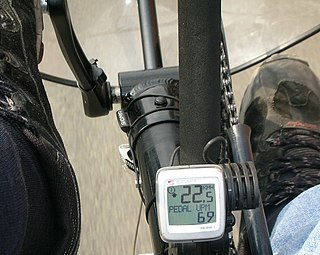 W
WIn cycling, cadence is the number of revolutions of the crank per minute; this is the rate at which a cyclist is pedalling/turning the pedals. Cadence is directly proportional to wheel speed, but is a distinct measurement and changes with gearing—which determines the ratio of crank rpm to wheel rpm.
 W
WChainline is the angle of a bicycle chain relative to the centerline of the bicycle frame. A bicycle is said to have perfect chainline if the chain is parallel to the centerline of the frame, which means that the rear sprocket is directly behind the front chainring. Chainline also refers to the distance between a sprocket and the centerline of the frame.
 W
WCold-weather biking or winter biking is the use of a bicycle during months when roads and paths are covered with ice, slush and snow. Cold weather cyclists face a number of challenges in near or below freezing temperatures. Urban commuters on city streets may have to deal with "[s]now, slush, salt, and sand", which can cause rust and damage to metal bike components. Slush and ice can jam derailleurs. Some cyclists may bike differently in winter, by "slow[ing] down on turns and brak[ing] gradually" in icy conditions. Gaining traction on snow and ice-covered roads can be difficult. Winter cyclists may use bikes with front and rear fenders, metal studded winter tires and flashing LED lights. Winter cyclists may wear layers of warm clothes and "ea[r], face, and han[d]" coverings may be used. Specialized winter bikes called fatbikes, which have wide, oversized tires that are typically inflated with low pressure, are used in snow trail riding and winter bike competitions.
 W
WCountersteering is used by single-track vehicle operators, such as cyclists and motorcyclists, to initiate a turn toward a given direction by momentarily steering counter to the desired direction. To negotiate a turn successfully, the combined center of mass of the rider and the single-track vehicle must first be leaned in the direction of the turn, and steering briefly in the opposite direction causes that lean. The rider's action of countersteering is sometimes referred to as "giving a steering command".
 W
WBicycle culture can refer to a mainstream culture that supports the use of bicycles or to a subculture. Although "bike culture" is often used to refer to various forms of associated fashion, it is erroneous to call fashion in and of itself a culture.
 W
WCycle sport is competitive physical activity using bicycles. There are several categories of bicycle racing including road bicycle racing, time trialling, cyclo-cross, mountain bike racing, track cycling, BMX, and cycle speedway. Non-racing cycling sports include artistic cycling, cycle polo, freestyle BMX and mountain bike trials. The Union Cycliste Internationale (UCI) is the world governing body for cycling and international competitive cycling events. The International Human Powered Vehicle Association is the governing body for human-powered vehicles that imposes far fewer restrictions on their design than does the UCI. The UltraMarathon Cycling Association is the governing body for many ultra-distance cycling races.
 W
WCycling infrastructure refers to all infrastructure permissible for use by cyclists, including the network of roads and streets used by motorists, except where cyclists are excluded, along with bikeways from which motor vehicles are excluded – including bike paths, bike lanes, cycle tracks, rail trails and, where permitted, sidewalks. Cycling infrastructure also includes amenities such as bike racks for parking, shelters, service centers and specialized traffic signs and signals. Cycling modal share is strongly associated with the size of local cycling infrastructure.
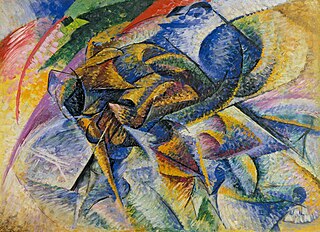 W
WDynamism of a Cyclist is a 1913 painting by Italian Futurist artist Umberto Boccioni (1882–1916) that demonstrates the Futurist preoccupation with speed, modern methods of transport, and the depiction of the dynamic sensation of movement.
 W
WThis is a glossary of terms and jargon used in cycling, mountain biking, and cycle sport.
 W
WA hill climb is a cycling event, as well as a basic skill of the sport. As events a hill climb may either be an individual time trial or a regular road race. A hill climb usually represents an event which gains altitude continuously, usually terminating at a summit. Well known US hill climbs include the Mt. Evans Hill Climb and the Mount Washington Auto Road Bicycle Hillclimb. Hill climbs occasionally feature in major professional races, such as the Tour de France, but they are usually referred to as mountain time trials, and are not necessarily from the bottom to the top of a hill, although they usually are.
 W
WLane splitting is riding a bicycle or motorcycle between lanes or rows of slow moving or stopped traffic moving in the same direction. It is sometimes called whitelining, or stripe-riding. This allows riders to save time, bypassing traffic congestion, and may also be safer than stopping behind stationary vehicles.
 W
WA local bike shop or local bicycle shop, sometimes abbreviated LBS, is a small business, as distinct from a chain, mail-order or online vendor, specializing in bicycle sale, maintenance and parts. In the UK and Ireland, the expression independent bicycle dealers (IBDs) is also used.
 W
WA bicycle mechanic or bike mechanic is a mechanic who can perform a wide range of repairs on bicycles. Bicycle mechanics can be employed in various types of stores, ranging from large department stores to small local bike shops; cycling teams, or bicycle manufacturers.
 W
WBicycle messengers are people who work for courier companies carrying and delivering items by bicycle. Bicycle messengers are most often found in the central business districts of metropolitan areas. Courier companies use bike messengers because bicycle travel is less subject to unexpected holdups in city traffic jams, and is not deterred by parking limitations, fees or fines in high-density development that can hinder or prevent delivery by motor vehicle, thereby offering a predictable delivery time.
 W
WNude recreation refers to recreational activities which some people engage in while nude. Historically, the ancient Olympics were nude events. There remain some societies in Africa, Oceania, and South America that continue to engage in everyday public activities —including sports— without clothes, while in most of the world nude activities take place in either private spaces or separate clothing optional areas in public spaces. Occasional events, such as nude bike rides, may occur in public areas where nudity is not otherwise allowed.
 W
WPara-cycling is the sport of cycling adapted for cyclists who have various disabilities. It is governed by the Union Cycliste Internationale (UCI). The sport consists of seven different events which include road and track races. The world's elite para-cyclists compete at Track and Road Worlds Championships, the Paralympic Games and the World Cup.
 W
WA pump track is a circuit of rollers, banked turns and features designed to be ridden completely by riders "pumping"—generating momentum by up and down body movements, instead of pedaling or pushing. It was originally designed for the mountain bike and BMX scene, and now, due to concrete constructions, is also used by skateboard, and accessible to wheelchairs. Pump tracks are relatively simple to use and cheap to construct, and cater to a wide variety of rider skill levels.
 W
WRoad cycling is the most widespread form of cycling. It includes recreational, racing, commuting, and utility cycling. Road cyclists are generally expected to obey the same rules and laws as other vehicle drivers or riders and may also be vehicular cyclists.
 W
WBicycle safety is the use of road traffic safety practices to reduce risk associated with cycling. Risk can be defined as the number of incidents occurring for a given amount of cycling. In many countries both the number of incidents and the amount of cycling are not well known. Non-fatal accidents often go unreported and bicycle use is only occasionally monitored. Some of this subject matter is hotly debated: for example, the discussions as to whether bicycle helmets or cyclepaths really improve safety. The merits of obeying the rules of the road including the use of bicycle lighting at night are less controversial.
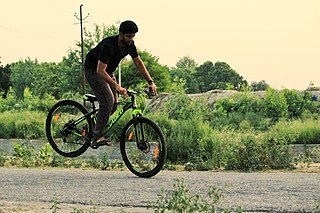 W
WThe stoppie is a motorcycle and bicycle trick in which the back wheel is lifted and the bike is ridden on the front wheel by carefully applying brake pressure. It is also called an endo, or less commonly, a front wheelie.
 W
WThe Stoppomat is a time measure system for cyclists.
 W
WBicycle theft is the crime of stealing a bicycle.
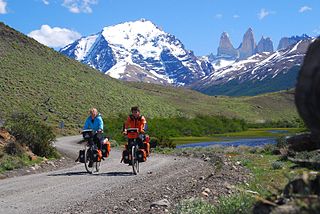 W
WBicycle touring is the taking of self-contained cycling trips for pleasure, adventure or autonomy rather than sport, commuting or exercise. Touring can range from single-day trips, to multi-day trips, to years. Tours may be planned by the participant or organised by a holiday business, a club, or a charity as a fund-raising venture.
 W
WThe track stand or standstill is a technique that bicycle riders can use to maintain balance while their bicycle remains stationary or moves only minimal distances. The technique originated in track cycling and is now used by other types of cyclists wishing to stop for a short time without putting a foot on the ground, such as bike commuters at stop signs. To perform a track stand, a cyclist holds the cranks in an approximately horizontal position with the front wheel steered to the left or right, and pedals forward, and back in the case of a fixed-gear bicycle, which the steered front wheel converts into a side-to-side motion.
 W
WTrail riding is riding outdoors on trails, bridle paths, and forest roads, but not on roads regularly used by motorised traffic. A trail ride can be of any length, including a long distance, multi-day trip. It originated with horse riding, and in North America, the equestrian form is usually called "trail riding," or, less often "hacking." In the UK and Europe, the practice is usually called horse or pony trekking.
 W
WA two-mass-skate bicycle (TMS) is a theoretical model created by a team of researchers at Cornell University, University of Wisconsin-Stout, and Delft University of Technology to show that it is neither sufficient nor necessary for a bike to have gyroscopic effects or positive trail to be self-stable. The two-mass and skates aspects of the model were chosen to eliminate design parameters so that the nine that remain, the locations of the masses and the steering geometry, could be more easily analyzed. Instead of full inertia tensors, the total mass of the bike is reduced to just two point masses, one attached to the rear frame and one attached to the front fork. Instead of rotating wheels, the non-holonomic ground contacts are provided by small-radius skates.
 W
WWheelbuilding is the process of assembling wire wheels. The components of a wire wheel are the rim, spokes, nipples, and hub.
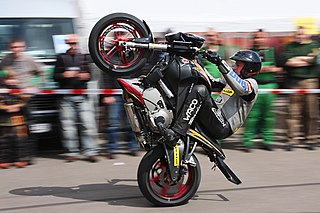 W
WIn vehicle acrobatics, a wheelie, or wheelstand, is a vehicle maneuver in which the front wheel or wheels come off the ground due to sufficient torque being applied to the rear wheel or wheels, or rider motion relative to the vehicle. Wheelies are usually associated with bicycles and motorcycles, but can be done with other vehicles such as cars, especially in drag racing and tractor pulling.
 W
WZwift is a massively multiplayer online cycling and running physical training program that enables users to interact, train and compete in a virtual world. The company responsible for Zwift, Zwift Inc., was cofounded by Jon Mayfield, Eric Min, Scott Barger and Alarik Myrin in California, United States, in 2014. The Zwift game was released in its beta version in September 2014 and became a paid product with a fee of $10 per month in October 2015.They raised their monthly membership to $ 14.99 in November 2017.